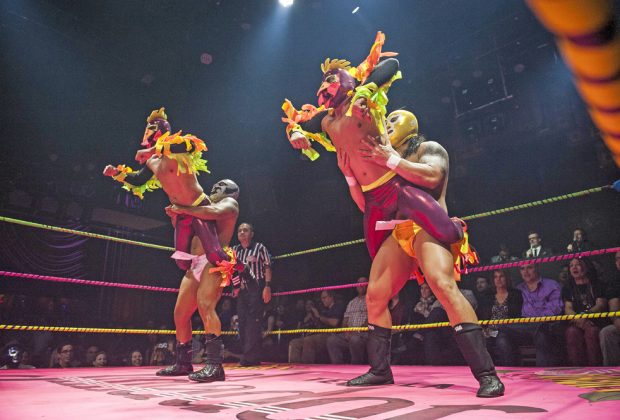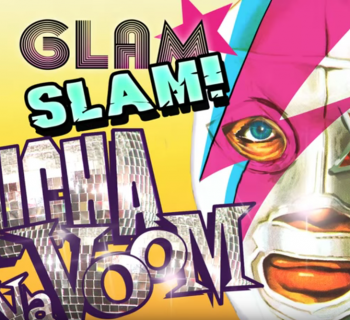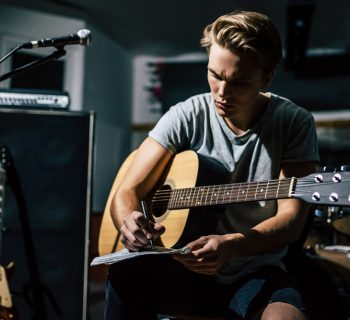In 2002, Liz Fairbairn and Rita D’Albert had a plan to combine performances from several local subcultures into one grand event. Combining Mexican wrestling with updated “punk rock” burlesque, and low-rider car enthusiasts into a spectacle in downtown Los Angeles, the first installment of Lucha VaVOOM debuted at the historic Mayan Theatre. “We put on that first show by the skin of our teeth,” says Fairbairn. “And we broke even! So we knew we had something. Everyone demanded that we keep it going.”
Fourteen years and dozens of shows later, Lucha VaVOOM continues to sell out, with six or so shows a year in Los Angeles and productions in New York City, Chicago and San Francisco. How did this labor of love keep on drawing an audience and sustaining profitability?
“We care about the quality of the show,” says Fairbairn, who managed theatrical punk/metal band GWAR for several years. “We don’t want to burn out the audience.” The show changes content with each performance, and each show sticks to a loose theme. Valentine’s Day, Halloween and Cinco de Mayo shows are annual traditions, with others throughout the year, including this June’s Glam Slam, honoring the legacies of David Bowie and Prince.
Each performance includes professional “free style” Mexican wrestling, including masked combatants and a loose story line, as well as sexy burlesque dancers, a comedian emcee, aerial acts and other unique entertainers. The concept originated with Fairbairn’s fascination with the pageantry of Mexican wrestling, which germinated when she was a costume designer on a film shoot in Mexico City. “I was obsessed with the culture. I met several wrestlers while I was working in Mexico City, and when I got back to L.A., I couldn’t stop blabbing about it,” she says.
 Fairbairn was designing costumes for friend Rita D’Albert and her burlesque troupe Velvet Hammer when the pair came up with the idea to combine the two concepts and put together the first show. “Over the years, there have been some hard times in the world, and Lucha VaVOOM is a safe place to have fun and be distracted for a while,” Fairbairn says. The two create the shows together, with input from the performers and crew. Much of the content is finalized at the last minute. “We work together like a writer’s room, but without a script!”
Fairbairn was designing costumes for friend Rita D’Albert and her burlesque troupe Velvet Hammer when the pair came up with the idea to combine the two concepts and put together the first show. “Over the years, there have been some hard times in the world, and Lucha VaVOOM is a safe place to have fun and be distracted for a while,” Fairbairn says. The two create the shows together, with input from the performers and crew. Much of the content is finalized at the last minute. “We work together like a writer’s room, but without a script!”
The spontaneity of the production results in a semi-chaotic, but ultimately well-orchestrated show. “We have two show runners who work the stage cues, and we just do basically a lighting and sound check before the shows,” notes Fairbairn. There are no full-on rehearsals or run-throughs. It is, however, a professional production. “We don’t use volunteers. Everyone gets paid.” For a recent show, she notes, there were about 40 people on payroll. For the car clubs that escort the performers to the show and line up outside in a grand vintage car parade, the company pays for their gas. The Aztec dancing troupe that performs gets paid a lump sum, “and however many dancers show up, show up.”
Co-conspirator D’Albert had been in bands in Los Angeles in addition to the Velvet Hammer troupe. “This is a lot less heartbreaking than being in a band,” she says, regarding the audience response. “At our first show, when I saw the audience reaction, I thought, ‘This isn’t the L.A. audience I know.’ They were going crazy!”
D’Albert believes that Los Angeles is always the toughest crowd. “They’ve seen too much,” she explains. “So we have to keep the show changing, keep tightening the pace. The show has to keep US entertained! We aren’t ironic—our shows are a joyous approach to entertainment. They are open-minded and not cynical.”
When taking the show on the road, the producers tap into local talent. “Thanks to social media, we have access to a talent pool around the world,” D’Albert explains.
Social media was in its infancy during those first few years. “At one point, we hired a social media company and that didn’t work,” recalls Fairbairn. “They posted things that we would never post, quotes we would never say.” The producers have kept the social media in-house since, maintained by D’Albert’s husband, Segan Friend, who also creates the graphics and handles the merch for Lucha VaVOOM (luchavavoom.com).
D’Albert and Fairbairn advise those considering launching an ambitious project to “just do it!” Adds D’Albert, “If you have a clear vision and you can be theatrical, go for it, because I want to see it!”
Photo (of Rita) by Don Spino
Contact Mike Gowen of MSO PR














